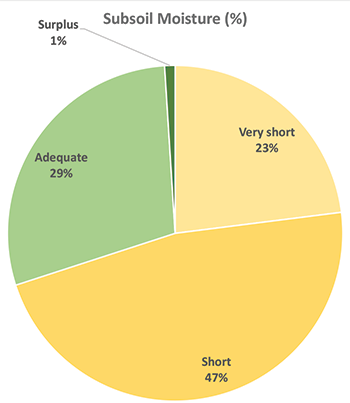Planting wheat into dry soil
Three options to consider when planting wheat into dry soil.
Wheat seed should be planted into soils between 54 and 77 degrees Fahrenheit. Soil must have 35–45 percent water by weight in order for the seed to imbibe enough water to germinate, according to a 1975 publication in the journal “Crop Physiology” by L.T. Evans. Currently in Michigan, we are seeing some abnormally dry conditions, with little or no rain forecast for the next eight to 10 days. According to the Sept. 25, 2017, Michigan Crop Weather Report by the National Agriculture Statistics Service, reported topsoil and subsoil moisture conditions are 73 percent and 70 percent short or very short, respectively (see graphs).


When planting wheat into dry soil conditions, there are three potential scenarios to choose from as described below.
1. Dust it in at the normal seeding depth and normal planting date—and hope for rain.
This is probably the best option. The seed will remain viable in the soil until it gets enough moisture. Before planting, look at the long-term forecast and try to estimate how long the dry conditions will persist. If it looks like there’s a good chance the dry weather will continue until at least the back end of the optimum range of planting dates, treat the fields as if you were planting later than the optimum time.
Rather than cutting back on seeding rates and fertilizer to save money on a lost cause, increase seeding rates and consider using a fungicide seed treatment and a starter fertilizer. The idea is to make sure the wheat gets off to a good start and will have enough heads to have good yield potential, assuming it will eventually rain and the crop will emerge late. Wheat that emerges in November almost always has fewer fall tillers than wheat that emerges in September or October.
There are some risks to this option. For one thing, a hard rain could crust over the soil or wash soil off planting ridges and into the seed furrows, potentially causing emergence problems. Another factor is the potential for wind erosion. Also, the wheat may not come up until spring, in which case it may have been better not to plant the wheat at all and plant a spring crop instead.
Probably the worst-case scenario for this option would be if a light rain occurs and the seed gets just enough moisture to germinate, but not enough for the seedlings to emerge through the soil or survive very long if dry conditions return. This could result in a loss of the stand.
2. Plant deeper than normal into moisture now, if possible.
This option can work if the variety to be planted has a long coleoptile, you use a hoe drill and there is good moisture within reach. The advantage of this option is that the crop should come up and make a stand during the optimum time in fall. This would keep the soil from blowing. Also, the ridges created by hoe drills also help keep the soil from blowing.
The main risk of this option is poor emergence. Deep-planted wheat normally has below-normal emergence, so a higher seeding rate should be used. Any rain that occurs before the seedlings have emerged could add additional soil into the seed furrow, making it even harder for the coleoptile to reach the soil surface. Any time you increase the seeding depth, the seedling will have to stay within the soil just that much longer before emerging through the soil surface.
Delayed emergence leads to more potential for disease and pest problems, and reduced tillering potential late in the season. It’s even possible that the wheat would get planted so deep that it would germinate but never emerge at all, especially if the coleoptile length is too short for the depth of planting. Generally speaking, it’s best to plant no deeper than 3 inches with most varieties.
3. Wait for a rain, and then plant.
To overcome the risk of crusting or stand failure, you may decide to wait until it has rained and soil moisture conditions are adequate before planting. Under the right conditions, this would result in good stands, assuming you use a high seeding rate and a starter fertilizer, if appropriate. If it remains dry well past the optimum range of planting dates, you would then have the option of just keeping the wheat seed in the shed until next fall and planting spring crop next year instead.
The risk of this option is that the weather may turn rainy and stay wet later this fall, preventing you from planting the wheat at all while those who “dusted” their wheat in have a good stand. There is also the risk of leaving the soil unprotected from the wind through the winter until the spring crop is planted.
Crop insurance considerations and deadlines will play a role in these decisions.
There has been some talk about whether soil moisture can move upward in the soil as the weather gets cooler, and whether this alone might provide enough moisture in the soil surface for wheat to germinate. While it’s true that a small amount of soil moisture will gradually migrate a bit toward cooler areas of the soil, there is no chance that enough moisture will move upward into the seed zone to germinate wheat simply because the temperature at the soil surface has cooled. Where soils are dry, it will take rainfall for wheat to germinate and emerge.
This article was adapted from Jim Shroyer, retired Extension agronomy state leader, and Loyd Stone, retired soil and water management, Kansas State University.



 Print
Print Email
Email